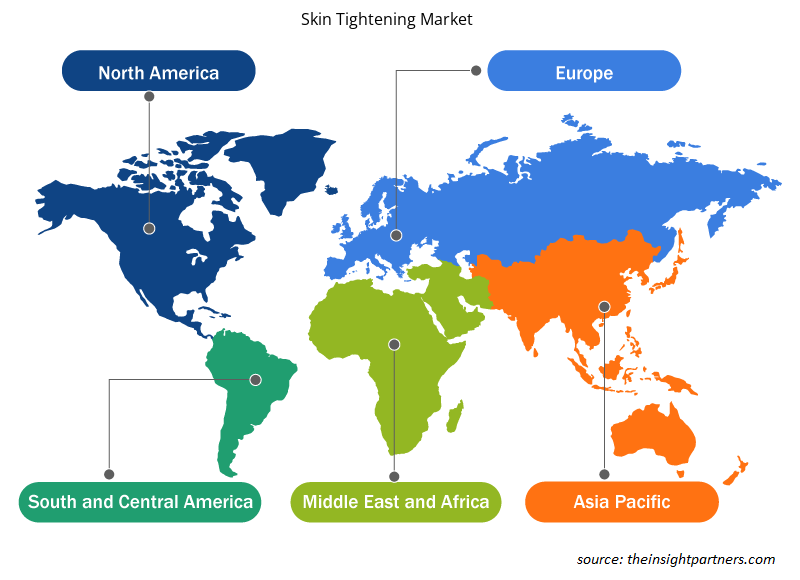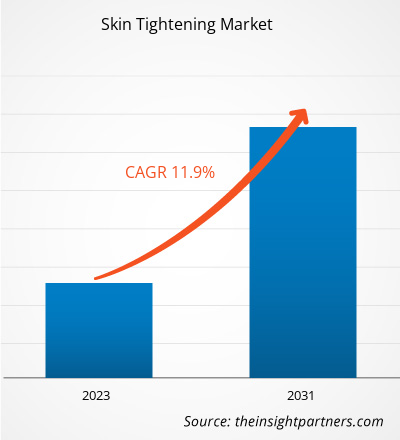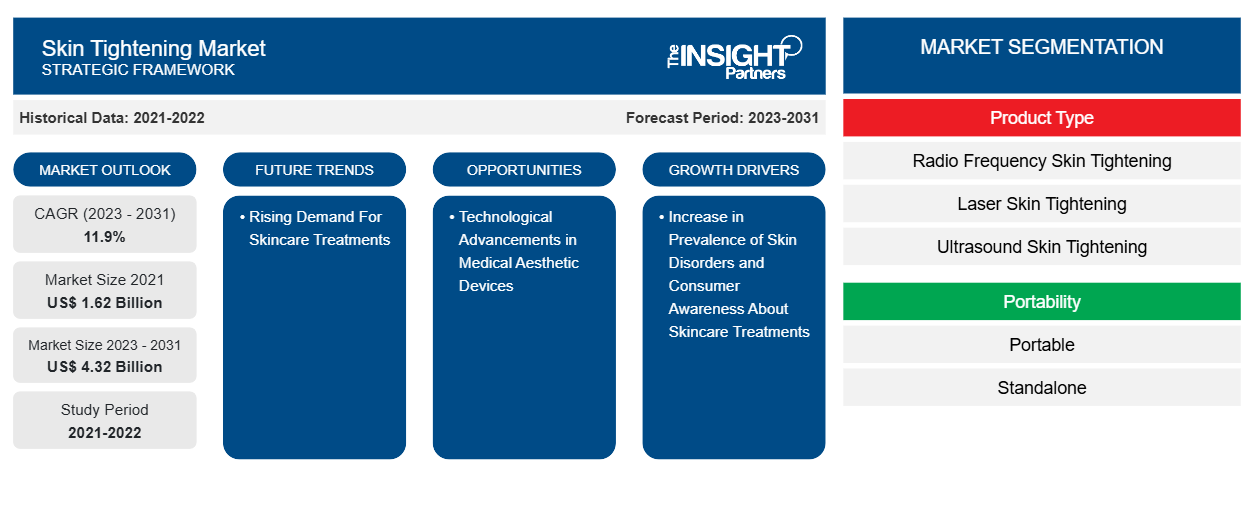Se estimó que el tamaño del mercado de estiramiento de la piel sería de 1.620 millones de dólares en 2021 y de XX mil millones de dólares en 2023, y se espera que alcance los 4.320 millones de dólares en 2031; se estima que registrará una CAGR del 11,9% en 2023-2031. Las iniciativas estratégicas en tecnología de estiramiento de la piel, el aumento de la prevalencia de trastornos cutáneos, la conciencia de los consumidores sobre los tratamientos para el cuidado de la piel y la creciente demanda de tratamientos para el cuidado de la piel son factores impulsores. Los avances tecnológicos en dispositivos médicos estéticos probablemente seguirán siendo clave para las tendencias del mercado de estiramiento de la piel. CAGR of 11.9% in 2023–2031. The strategic initiatives in skin tightening technology, the increase in the prevalence of skin disorders, consumer awareness about skincare treatments, and the rising demand for skincare treatments are driving factors. Technological advancements in medical aesthetic devices will likely remain key to skin-tightening market trends.
Análisis del mercado de reafirmación de la piel
Los procedimientos de estiramiento de la piel pueden ser invasivos, no invasivos o mínimamente invasivos para remodelar una parte del cuerpo y tensar la piel flácida. El estiramiento de la piel se puede realizar quirúrgicamente mediante liposucción o utilizando métodos menos invasivos como la criolipólisis, la lipólisis por inyección, la lipólisis por radiofrecuencia y la lipólisis láser. El objetivo principal de los procedimientos de estiramiento de la piel es eliminar los no deseados y lograr firmeza en el área de tratamiento. La liposucción o lipólisis, un procedimiento invasivo de contorno corporal, ha sido uno de los tratamientos de cirugía plástica más populares y demandados y es especialmente eficaz para eliminar la grasa de las piernas, la espalda, los brazos, el abdomen, el cuello y la cara.cryolipolysis, injection lipolysis, lipolysis, and laser lipolysis. The main goal of skin tightening procedures is to eliminate unwanted and achieve firmness in the treatment area. Liposuction or lipolysis, an invasive body contouring procedure, has been one of the most popular and in-demand plastic surgery treatments and is especially effective in removing fat from the legs, back, arms, abdomen, neck, and face.
Descripción general del mercado de estiramiento de la piel
La región de Asia Pacífico es el mercado de más rápido crecimiento para el estiramiento de la piel. El crecimiento se debe principalmente a los crecientes avances en la industria de dispositivos médicos, el creciente número de procedimientos estéticos médicos y las diversas clínicas estéticas que ofrecen tratamientos con láser. Según ISAPS, Australia se encuentra entre los 10 países que más dinero gastan en estética. La mayoría de las personas gastan en inyecciones antiarrugas y otros rellenos dérmicos. Los dispositivos de estiramiento de la piel más comunes utilizan tecnología de radiofrecuencia y energía ultrasónica para apuntar a la dermis más profunda y las capas subcutáneas de la piel, tensando la estructura del tejido subyacente sin dañar las capas externas de la piel.ISAPS, Australia ranks in the top 10 countries spending the most money on aesthetics. Most of the people spent on anti-wrinkle injections and other dermal fillers. Most common skin-tightening devices use radiofrequency technology and ultrasound energy to target the skin’s deeper dermis and subcutaneous layers, tightening the underlying tissue structure without harming the skin outer layers.
A partir del 1 de julio de 2023, la Agencia Australiana de Regulación de Profesionales de la Salud (AHPRA) implementó nuevas pautas para los médicos registrados que realizan procedimientos y cirugías cosméticas.AHPRA) implemented new Guidelines for registered medical practitioners who perform cosmetic procedures and surgery.
Personalice este informe según sus necesidades
Obtendrá personalización en cualquier informe, sin cargo, incluidas partes de este informe o análisis a nivel de país, paquete de datos de Excel, así como también grandes ofertas y descuentos para empresas emergentes y universidades.
-
Obtenga las principales tendencias clave del mercado de este informe.Esta muestra GRATUITA incluirá análisis de datos, desde tendencias del mercado hasta estimaciones y pronósticos.
Factores impulsores y oportunidades del mercado del estiramiento de la piel
Aumento de la prevalencia de trastornos de la piel y de la concienciación de los consumidores sobre los tratamientos para el cuidado de la piel
Según la Asociación de la Academia Estadounidense de Dermatología, el acné es la afección cutánea más común en los EE. UU. y afecta a unos 50 millones de estadounidenses al año. La creciente población geriátrica es propensa a las arrugas, por lo que está impulsando la demanda de tratamientos antienvejecimiento, tonificantes y de rejuvenecimiento de la piel para ocultar los signos del envejecimiento. Existe una demanda mundial de tratamientos con láser, contorno corporal y estiramiento de la piel. Según The Aesthetic Society, se ejecutaron 41.301 procesos de rejuvenecimiento de la piel en los EE. UU., lo que generó unos ingresos de 31.567.167 dólares estadounidenses en 2021. Además, la concienciación de los consumidores sobre los tratamientos para el cuidado de la piel está aumentando el número de medspas y clínicas de la piel que ofrecen tratamientos cutáneos razonables para diversas afecciones cutáneas.antiaging, toning, and skin rejuvenation treatments to hide the signs of aging. There is a global demand for laser treatments, body contouring, and skin tightening. As per The Aesthetic Society, 41,301 skin rejuvenation processes were executed in the US, generating a revenue of US$ 31,567,167 in 2021. Also, consumer awareness about skincare treatments is increasing the number of medspas and skin clinics that provide reasonable skin treatments for various skin conditions.
Demanda creciente de tratamientos para el cuidado de la piel: una oportunidad
Existe una demanda global de tratamientos con láser, remodelación corporal y reafirmación de la piel. Se espera que las iniciativas de crecimiento orgánico e inorgánico de los actores clave ofrezcan oportunidades de crecimiento rentables para el crecimiento del mercado en el país. Por ejemplo, en octubre de 2020, se lanzó Endolift, un tratamiento con láser para reafirmar la piel, en el Reino Unido. Cuando se inserta debajo de la piel, el dispositivo utiliza fibra óptica para enviar energía láser directamente a la capa subcutánea. La energía inicia la remodelación del colágeno, lo que da como resultado un estiramiento visible de la piel. En febrero de 2024, Cutera lanzó comercialmente AviClear, el primer dispositivo basado en energía aprobado por la FDA para tratar el acné leve, moderado y severo. AviClear está disponible en el Reino Unido y Australia.
La adopción de dispositivos para tensar la piel ha aumentado significativamente en varios países de América del Norte, Europa y Asia.
Análisis de segmentación del informe de mercado de estiramiento de la piel
Los segmentos clave que contribuyeron a la derivación del análisis del mercado de estiramiento de la piel son el tipo de producto, la portabilidad, el tipo de tratamiento, la aplicación y el usuario final.
- Según el tipo de producto, el mercado de estiramiento de la piel se divide en estiramiento de la piel por radiofrecuencia, estiramiento de la piel con láser y estiramiento de la piel con ultrasonido. El segmento de estiramiento de la piel por radiofrecuencia tuvo la mayor participación del mercado en 2023. Además, se estima que el segmento de estiramiento de la piel con láser registrará la CAGR más alta del mercado durante el período de pronóstico.
- En función de la portabilidad, el mercado de estiramiento de la piel se divide en portátil e independiente. El segmento independiente tuvo la mayor participación del mercado en 2023. Además, se estima que el segmento portátil registrará la CAGR más alta del mercado durante el período de pronóstico.
- Según el tipo de tratamiento, el mercado de estiramiento de la piel se divide en no invasivo y mínimamente invasivo. El segmento no invasivo tuvo la mayor participación del mercado en 2023. Además, se estima que el mismo segmento registrará la CAGR más alta del mercado durante el período de pronóstico.
- Según la aplicación, el mercado de estiramiento de la piel se divide en reducción de arrugas, lifting facial, lifting corporal, antienvejecimiento y otros. El segmento antienvejecimiento tuvo la mayor participación del mercado en 2023. Además, se estima que el segmento de reducción de arrugas registrará la CAGR más alta del mercado durante el período de pronóstico.
- Según el usuario final, el mercado de estiramiento de la piel se segmenta en clínicas de dermatología, hospitales, salones de belleza y centros de cosmética, y atención domiciliaria. El segmento de clínicas de dermatología tuvo la mayor participación del mercado en 2023. Sin embargo, se proyecta que el segmento de salones de belleza y centros de cosmética registre la CAGR más alta del mercado durante el período de pronóstico.
Análisis de la cuota de mercado de los tratamientos de reafirmación de la piel por geografía
El alcance geográfico del informe de mercado de estiramiento de la piel se divide principalmente en cinco regiones: América del Norte, Asia Pacífico, Europa, Medio Oriente y África, y América del Sur / América del Sur y Central.
América del Norte ha dominado el mercado del estiramiento de la piel. El crecimiento del mercado se atribuye a un aumento en la prevalencia de trastornos de la piel, la conciencia de los consumidores sobre los tratamientos para el cuidado de la piel y un aumento en la aceptación de procedimientos médicos estéticos no invasivos y mínimamente invasivos. Además, los lanzamientos y las aprobaciones de nuevos productos para realizar estiramientos de la piel están creciendo significativamente en el país. Se prevé que Asia Pacífico crezca con la CAGR más alta en los próximos años.
Perspectivas regionales del mercado de reafirmación de la piel
Los analistas de Insight Partners explicaron en detalle las tendencias y los factores regionales que influyen en el mercado de reafirmación de la piel durante el período de pronóstico. Esta sección también analiza los segmentos y la geografía del mercado de reafirmación de la piel en América del Norte, Europa, Asia Pacífico, Oriente Medio y África, y América del Sur y Central.

- Obtenga datos regionales específicos para el mercado de estiramiento de la piel
Alcance del informe de mercado sobre el estiramiento de la piel
| Atributo del informe | Detalles |
|---|---|
| Tamaño del mercado en 2021 | 1.620 millones de dólares estadounidenses |
| Tamaño del mercado en 2031 | US$ 4.32 mil millones |
| CAGR global (2023 - 2031) | 11,9% |
| Datos históricos | 2021-2022 |
| Período de pronóstico | 2023-2031 |
| Segmentos cubiertos |
Por tipo de producto
|
| Regiones y países cubiertos |
América del norte
|
| Líderes del mercado y perfiles de empresas clave |
|
Densidad de actores del mercado de reafirmación de la piel: comprensión de su impacto en la dinámica empresarial
El mercado de reafirmación de la piel está creciendo rápidamente, impulsado por la creciente demanda de los usuarios finales debido a factores como la evolución de las preferencias de los consumidores, los avances tecnológicos y una mayor conciencia de los beneficios del producto. A medida que aumenta la demanda, las empresas amplían sus ofertas, innovan para satisfacer las necesidades de los consumidores y aprovechan las tendencias emergentes, lo que impulsa aún más el crecimiento del mercado.
La densidad de actores del mercado se refiere a la distribución de las empresas o firmas que operan dentro de un mercado o industria en particular. Indica cuántos competidores (actores del mercado) están presentes en un espacio de mercado determinado en relación con su tamaño o valor total de mercado.
Las principales empresas que operan en el mercado del estiramiento de la piel son:
- Merz PharmaCutera Inc.
- Láseres Alma
- BRERA TECNOLOGÍAS MÉDICAS SRL
- Pológeno
- BISONTE MEDICO
- Osa Menor
Descargo de responsabilidad : Las empresas enumeradas anteriormente no están clasificadas en ningún orden particular.

- Obtenga una descripción general de los principales actores clave del mercado de estiramiento de la piel
Noticias y desarrollos recientes del mercado del estiramiento de la piel
El mercado de los tratamientos de reafirmación de la piel se evalúa mediante la recopilación de datos cualitativos y cuantitativos de investigaciones primarias y secundarias, que incluyen publicaciones corporativas importantes, datos de asociaciones y bases de datos. A continuación, se incluye una lista de los avances en el mercado de los tratamientos de reafirmación de la piel:
- RIVER AESTHETICS lanzó un tratamiento nuevo e innovador para nuestra amplia gama de procedimientos no quirúrgicos para rostro, cuerpo y piel: PROFHILO body. Profhilo es la única solución inyectable disponible que trata específicamente la flacidez corporal. Se inyecta en varios puntos alrededor del área tratada y libera lentamente la mayor concentración de ácido hialurónico ultrapuro del mercado, rellenando las arrugas e hidratando profundamente la piel para lograr un tensado visible. (Fuente: RIVER AESTHETICS/Comunicado de prensa, febrero de 2024)
- Reveal Lasers anunció el lanzamiento de su dispositivo, Denza, que cuenta con radiofrecuencia monopolar + bipolar con tecnología de pulso secuencial. Este dispositivo no solo ofrece resultados sorprendentes en el estiramiento de la piel, sino que lo hace con una elegancia que coincide con su eficiencia. (Fuente: Reveal Lasers, comunicado de prensa, octubre de 2023)
Informe de mercado sobre el estiramiento de la piel: cobertura y resultados
El informe “Tamaño y pronóstico del mercado de estiramiento de la piel (2021-2031)” proporciona un análisis detallado del mercado que cubre las siguientes áreas:
- Tamaño del mercado y pronóstico a nivel global, regional y nacional para todos los segmentos clave del mercado cubiertos bajo el alcance
- Dinámica del mercado, como impulsores, restricciones y oportunidades clave
- Principales tendencias futuras
- Análisis detallado de las cinco fuerzas de Porter y PEST y FODA
- Análisis del mercado global y regional que cubre las tendencias clave del mercado, los principales actores, las regulaciones y los desarrollos recientes del mercado.
- Análisis del panorama de la industria y de la competencia que abarca la concentración del mercado, el análisis de mapas de calor, los actores destacados y los desarrollos recientes
- Perfiles detallados de empresas
- Análisis histórico (2 años), año base, pronóstico (7 años) con CAGR
- Análisis PEST y FODA
- Tamaño del mercado, valor/volumen: global, regional y nacional
- Industria y panorama competitivo
- Conjunto de datos de Excel
Informes recientes
Testimonios
Razón para comprar
- Toma de decisiones informada
- Comprensión de la dinámica del mercado
- Análisis competitivo
- Información sobre clientes
- Pronósticos del mercado
- Mitigación de riesgos
- Planificación estratégica
- Justificación de la inversión
- Identificación de mercados emergentes
- Mejora de las estrategias de marketing
- Impulso de la eficiencia operativa
- Alineación con las tendencias regulatorias























 Obtenga una muestra gratuita para - Mercado de reafirmación de la piel
Obtenga una muestra gratuita para - Mercado de reafirmación de la piel